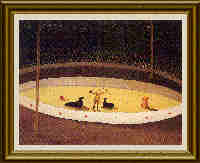Mark Heyer: Recent Paintings at Lohin-Geduld March 24-April 23
by Donna Maria de Creeft

1. Mark Heyer [Untitled]
Occasionally his deadpan titles guide the narrative direction. "On Second Thought", for example, shows a mounted train robber with guns blazing, racing past a steaming locomotive going the opposite way. Or "Bad Kitty", in which a woman, half-dressed in black lingerie, admonishes her mischievous cat.
Others seem obvious enough. "Flight" shows a tiny bi-plane flying over a moonlit landscape, but "Turbulence" an unsettling vision, in ominous grays and sulfuric yellows, of a young girl watching an advancing tornado, seems allegorical.
Questions arise, when considering Mark Heyer's work, now on view at Lohin-Geduld gallery. Is he a post-modernist ironist, or an insider aspiring to be an outsider? Is he following the precedent of exploring an art form that circumvents the aesthetics of the contemporary art "academy", or is he just an observer who has adopted a genre that suits his story-telling frame of mind?
The art-historical references in Heyer's work lead one to assume he's seen the primitive classics: Piero della Francesca, Sassetta, Ryder and Hicks, among others. His harlequin walking a pig at twilight in "Going to Market" is delicately reminiscent of a certain Rousseau, and affection for the fine naïve maritime paintings of New England is evident in his whaling scene, "Darting Distance". Heyer's fascination with oddity, seen in his painting of four impassive women and a lion out for "A Sunday Stroll", is characteristic of outsider art. Yet formalism also gets his message across. In "Getting Ready", a skillfully distorted woman is centered against a background of furniture and shadows that point with dizzying geometry toward the darkness of the open door behind her.
It seems unfair to load too much theoretical baggage on Heyer's charming, intimate, works. They have the graphic immediacy and technical crudity of naïve or outsider art. If anything, his nostalgia for an art form of such narrative simplicity, and gentle, sometimes corny, humor suggests he's not all that post-modern. Heyer's titles may hint at the self-referential irony of post-modernism but his visual imagery has the melancholy sincerity that characterizes nostalgia. If one thinks of his paintings as symbols of a genre, rather than symbolic in content, then one could say Heyer is post-modernist, unless one believes that nostalgia and irony are mutually exclusive.
Text copyright © 2005 Donna Maria de Creeft
 back to Contents page
back to Contents page